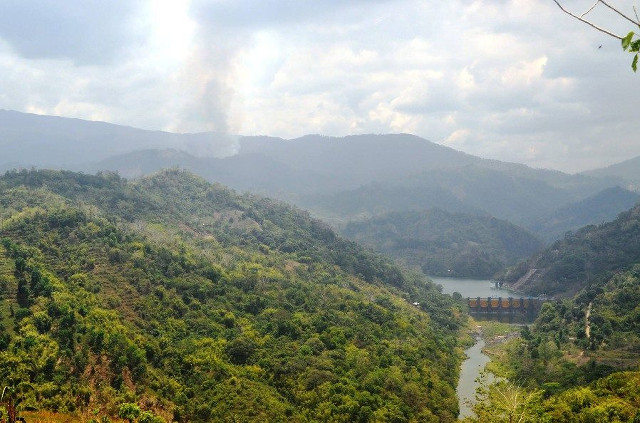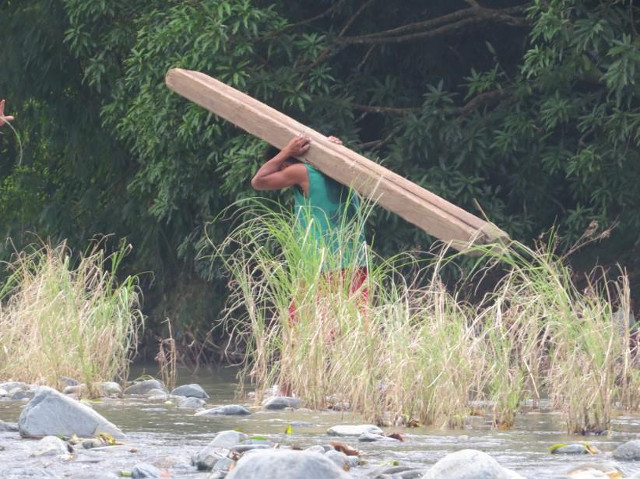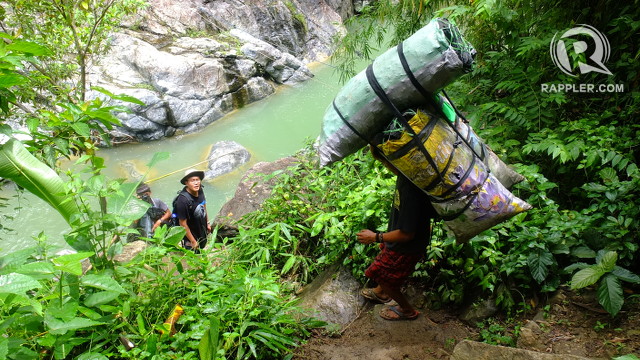SUMMARY
This is AI generated summarization, which may have errors. For context, always refer to the full article.

BULACAN, Philippines – In the Ipo watershed in Norzgaray, Bulacan, large brown spots of burnt forest stain the mountainside like bruises.
The cry of a chainsaw can be heard, a sad substitute for bird calls. A steady stream of smoke rises from a distant hillside, which our guide tells me is likely from charcoal-making.
Further on the trail, a local carrying 3 bulging sacks of charcoal passes by our group on his way to the market.
We pass by quaint patches of vegetables where mighty dipterocarp trees once lorded over teeming wildlife before they were burnt and cut by informal settlers.
None of these activities are supposed to be allowed inside a watershed because the law recognizes the role trees play in providing human communities with safe drinking water.
The Ipo watershed’s 6,600 hectares of forest provides fresh water to more than 11 million people in Metro Manila by generating water that flows to the Ipo Dam and then to La Mesa Dam.
Yet as early as 2004, the Department of Environment and Natural Resources (DENR) identified illegal logging, slash-and-burn farming (kaingin), and charcoal-making as main causes of deforestation here.
Most of those engaging in the illegal activities are informal settlers: some Bulakeño locals, some migrants from as far as Visayas and Mindanao.
Intermarrying between Dumagats (whose ancestral domain includes 800 hectares of the watershed) and Tagalogs also produced a new generation of locals who do not necessarily adhere to the more sustainable cultural practices and lifestyle of the tribe, said Sagip Sierra Madre Environmental Society president Brother Martin Francisco.
There are at least 500 families living inside the watershed, he added.
A militant group called the Lost Command, a group similar in its communist leaning to the New People’s Army (NPA), is largely responsible for the illegal logging. Profits earned from this lucrative livelihood are used to buy more weapons to make the group even more untouchable.
With the continued destructive activities, only around 30% of the watershed’s forest remains intact.
No trees, no water
A watershed needs trees in order to absorb rainwater which it channels into streams, rivers and eventually dams where human communities source fresh water. (READ: Runners race to save endangered watershed)
A typical tree breathes out 250 to 400 gallons of water per day through its leaves, humidifying the air. This process, called evapotranspiration, is responsible for most of the rain that falls inland, far from oceans.
Thus, without trees, there is no rain and it is rain that supplies much of the freshwater humans need to live.

The rampant deforestation has already begun to take its toll on the Ipo watershed’s ability to generate water for the millions of Metro Manila residents who depend on it.
Cernan (not his real name), an informal settler who has lived inside the watershed for decades, has watched the Ipo river shrink year by year during the dry season.
“Nung nakaraang summer, lumiit nang lumiit yung tubig. Sa susunod na taon, ‘pag nadagdagan pa rin yung pagputol ng puno, baka matuyo nang husto (Last summer, the river got smaller and smaller. Next year, if the deforestation continues, it might dry up for good),” he told Rappler.
The elevated parts of the watershed used to be covered in fog or low clouds, he said. Now the clouds are rare, a sign that the loss of trees has affected the watershed’s hydrological cycle.
The loss of trees has also led to more landslides along the river, said Cernan.
When soil from landslide falls into the water, they cause siltation which dirties the water and reduces the ability of the river to hold water. With soil falling to the bottom and displacing water, the water has nowhere to go but lowland communities.
The watershed-dwelling families harm the water supply in another way, said Francisco.
They often use the water to wash their laundry, throw their garbage into the water or even defecate directly into it.
Siltation from landslides and pollution make water from the river harder to clean.
This could eventually lead to higher water fees for consumers because concessionaires would now have to invest in more powerful filtration technology, said Francisco.
Mismanagement
His organization and the University of the Philippines (UP) Mountaineers, another group committed to protecting Ipo watershed, blame government mismanagement for the deforestation.
The DENR and the Metropolitan Waterworks and Sewerage System (MWSS) are jointly responsible for keeping the Ipo watershed healthy.
The MWSS was put in charge of managing the water supply while DENR is in charge of protecting the watershed.
But misunderstanding between the two agencies has led to poor management of the vital watershed.
“There’s just too much complications between our agencies. Truth to tell, given government bureaucracy, it’s a bit complicated,” admitted MWSS administrator Gerrry Esquivel to Rappler.
On the part of the state agency, Esquivel says MWSS does not have the police power to stop the destructive activities in the watershed.
“We don’t have guns, or cudgels or a police car.”
But the agency that does have the police power, or at least mandate to protect the watershed, lacks the resources to do it effectively.
DENR Secretary Ramon Paje and City Environment and Roger Encarnacion, Natural Resource Officer for Tabang, Bulacan, did not respond to Rappler’s texts for comment on the matter.
But Francisco said the unabated and blatant illegal activities point to the ineffectiveness of the local DENR to protect the watershed.
He said the solution to improved forest protection could be funds sourced from the environmental fee levied by the water concessionaires using the Ipo Dam. But Esquivel says concessionaires already use it for waste water treatment.
“But shouldn’t it be used to protect the source of your water?” asked Francisco.
“Concessionaires don’t want to give the fees to MWSS for the watershed because they say DENR doesn’t have a clear plan anyway. It may just be misused. The DENR doesn’t like how the concessionaires are interfering with their mandate. They’re pointing fingers at each other.”

Clear action plan needed
Esquivel said he has already told Paje of the perilous condition of the Ipo watershed. After his confirmation as secretary, Paje supposedly called him to meet within the month on an action plan.
“There needs to be a clear delineation of responsibilities. We may have resource and funding but it will all be for nothing without a clear mapping of what to do,” said Esquivel.
If things go from bad to worse in the Ipo watershed, it’s the people who live far from it who will be most affected, said Cernan.
“Sino ang maapektuhan? Hindi kaming nasa bundukan kasi kaunti lang kami rito. Ang mga mapeperwisyo ang nasa patag, sa Maynila. Pag bumaha, saan babaha? Marami akong tanim na gulay; may root crops ako rito. Preparasyon ko ‘yun pag sumama ang panahon. Sila, preparado ba?“
(Who will be affected? Not us in the mountains because we are very few. The ones who will have problems are those living in the lowlands, in Manila. When it floods, where will it flood? I have many vegetables here; I have root crops. This is my preparation for bad weather. Are they prepared?) – Rappler.com
Add a comment
How does this make you feel?

There are no comments yet. Add your comment to start the conversation.